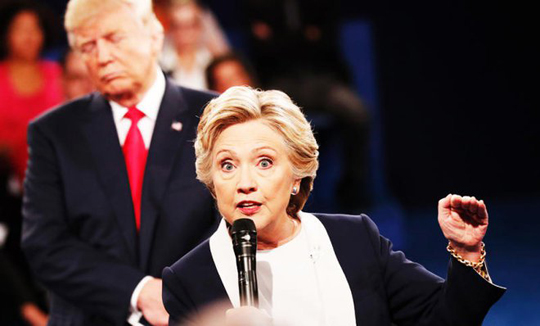Jeddah, Oct 11: The second US presidential debate on Sunday between Donald Trump and Hillary Clinton left Arab analysts astonished “as it displayed two different Americas.”

Jordan's former Information Minister Saleh Al-Qallab said Clinton performed well.
“She made some very good points against Trump, and if she wins — and I hope she does — it will be good for Syria and the entire Middle East,” he told Arab News from Amman on Tuesday.
Al-Qallab felt Trump seems to incline toward Russian President Vladimir Putin when it comes to Syria.
“To me, there were clear signs during the course of the debate that Trump wants to hedge his bets on Russia ... He is going over to Russia,” he said. “No worry, he is not going to win.”
Al-Qallab said the world is once again divided between the East and the West, just like it was during the Cold War.
Clinton was “very clear” in her opposition to Russia. “She is not going to be like US President Barack Obama who turned out to be very, very weak,” he said. “Clinton is not going to treat Russia like Obama did. She is going to be tough.”
Al-Qallab's verdict: “Clinton won. Trump fought hard, but in the end, he was defeated.”
Joyce Karam, Al-Hayat's Washington bureau chief, told Arab News that there were two visions of America on display on Sunday night, “one of Trump and the other of Clinton.”
She felt Trump “did better stylistically” when compared to the first debate. “However, that was not enough for him to deliver the knockout blow to Clinton,” she said. “He needed a knockout to rebalance his position in the race.”
She said there were stark differences between the two nominees on the many issues that endanger the US and the rest of the world. “Take the Middle East, for example, and look how they are viewing what is happening in Syria,” she said. “It was astonishing to see Trump actually describing the bombardment and the razing of Aleppo as fighting ISIS.”
She was equally shocked by Trump's defending Russia in the hacking controversy.
“This comes two days after the US intelligence had officially confirmed that Russia is involved in the hacking,” she said.
“When they asked him about Syria, and the need to meet Russian provocations with US strength and military force, as advocated by his running mate (Mike Pence), Trump said, ‘I haven't spoken to him recently. Right now, Syria is fighting ISIS.'”
For Karam, that was a revealing moment of the debate. “This shows how stubborn Trump is and how detached he is from the foreign policy reality and national security interests of the United States.”
According to her, people are surprised that a US presidential nominee should be in the same camp as Assad and Russia “at a time when the US has just launched an investigation into Russian war crimes in Aleppo.”
She said if Trump actually wins, that could lead to the US going into the Russian-Iranian camp over Syria. “That would be unprecedented in US foreign policy.”
She admitted that Trump did criticize the Iran nuclear deal. “But then there is no consistency in his foreign policy outlook. He says a lot of things that could ring well with his voters, but there is no real strategy, no clear outlook on how he defines US national security in the Middle East.”
Karam's verdict: “It was actually a draw. I don't think anybody emerged as a winner on Sunday night.”
Maha Akeel, a Jeddah-based Saudi journalist, said she did not like either candidate.
“But, if I have to choose, it would be Clinton because she is tough, experienced, smart and knows the issues, and you can tell that from her answers,” she said.
If she makes history as the first female US president “this will be good for women and girls around the world, especially since she is an advocate of women's rights and empowerment,” said Akeel.
Akeel's verdict: “I am not sure, but Trump did better this time.”
Alaa Abdel Ghani, former deputy editor-in-chief of Ahram Weekly, described the debate as “dirty.”
“We watched the debate with amusement and also disbelief as one candidate tells the other that if he becomes the president, he would put the other in jail. We have not seen anything like this before,” he told Arab News from Cairo. “I don't think it ever happened in US election history.
He rued the fact that nobody talked about the real issues that concern ordinary Americans, such as economy and health care.
“This was supposed to be a debate in which the people of the United States were supposed to participate; they were supposed to ask questions and seek answers. But since the focus was too much on the past history of Bill Clinton and his liaison with other women, and the infamous Trump tape, there was very little time for people to ask questions about their future and the future of America,” he said.
Ghani's verdict: “No clear winner.”





Comments
Add new comment